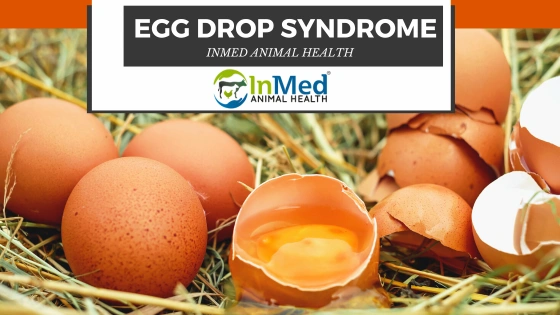- Veterinary PCD Pharma Franchise Company in PAN India.
- 9216295095
- inmedanimal@gmail.com
Impact of Egg Drop Syndrome on Hen Health and Egg Production
Veterinary Products Franchise: Opportunity for Entrepreneurs
June 20, 2023Top Nutraceutical Products for Dogs: Boosting Canine Health
October 18, 2023Impact of Egg Drop Syndrome on Hen Health and Egg Production

Egg Drop Syndrome is a highly contagious viral disease that poses a significant threat to egg production and hen health. Understanding the causes, symptoms and impact of EDS is crucial for implementing effective prevention and control measures. Strict biosecurity protocols, regular monitoring and prompt diagnosis are essential for managing the disease. It is caused by the Egg Drop Syndrome virus, which primarily affects the reproductive system of laying hens. The virus can be transmitted through contact with contaminated birds, equipment or even through the air.
What causes Egg Drop Syndrome?
Egg drop syndrome is caused by the virus belonging to the Adenoviridae family and is known to affect various avian species. The disease primarily affects hens of all ages, but older birds are more susceptible to the virus. The virus can survive in the environment for an extended period, making it challenging to control.
Virus can be introduced to a flock through infected birds or contaminated equipment. This virus can also be transmitted vertically from the hen to its offspring. Stress, poor nutrition and concurrent infections can weaken the immune system of hens, making them more susceptible to EDS.
What are the symptoms of Egg Drop Syndrome in hens?
Hens affected by Egg Drop Syndrome exhibit various symptoms and signs. These include a sudden drop in egg production, poor eggshell quality, soft-shelled or shell-less eggs, and a decrease in the size and weight of eggs. Affected hens may also show signs of depression, reduced appetite and increased mortality rates.
Other clinical signs of EDS include respiratory distress, swollen oviducts and abnormal egg shape. These symptoms, combined with the decline in egg production, can have a severe economic impact on egg producers.
How Egg Drop Syndrome affects egg production?
Egg Drop Syndrome has a significant impact on egg production in affected flocks. The sudden drop in egg production can result in significant financial losses for egg producers. The decrease in eggshell quality and abnormal egg shape further affect the marketability of eggs.
The Egg Drop Syndrome virus primarily affects the reproductive system of hens, leading to a decrease in egg production. The virus interferes with the normal functioning of the oviduct, resulting in the production of eggs with weak shells or no shells at all. This not only affects the quantity of eggs produced but also their quality.
Impact of EDS on hen health and welfare
EDS not only affects egg production but also has a significant impact on the health and welfare of hens. The virus weakens the immune system of affected birds, making them more susceptible to secondary infections. This can lead to increased mortality rates and a decline in overall flock health.
Hens affected by Egg Drop Syndrome may experience pain and discomfort due to the swelling of the oviduct and the production of abnormal eggs. The stress caused by the disease can further weaken the bird’s immune system, making them more prone to other diseases and reducing their overall welfare.
Is there any treatment of Egg Drop Syndrome?
Unfortunately, there is no specific treatment for Egg Drop Syndrome. Affected birds should be isolated from healthy ones to prevent further spread of the virus. Supportive care, such as providing a balanced feed, clean water and a stress-free environment, can help improve the overall health and well-being of affected hens.
Diagnosing Egg Drop Syndrome requires laboratory testing to detect the presence of the virus. Samples from affected hens, such as cloacal swabs or eggshell membranes, are collected and analyzed using techniques like polymerase chain reaction (PCR). Prompt and accurate diagnosis is crucial for implementing appropriate control measures.
How to prevent Egg Drop Syndrome?
Preventing Egg Drop Syndrome involves implementing strict biosecurity measures. This includes practicing good hygiene, such as regular disinfection of equipment and facilities, restricting access to visitors and maintaining proper waste management. Vaccination is also recommended to reduce the risk of EDS outbreaks.
Regular monitoring of flocks for any signs of EDS is essential for early detection and prompt intervention. Quarantine procedures should be followed when introducing new birds to a flock to prevent the introduction of the virus. Implementing these preventive measures can help minimize the risk and its impact on egg production.
Does biosecurity prevents Egg Drop Syndrome?
Biosecurity plays a crucial role in preventing Egg Drop Syndrome and other infectious diseases in poultry. Strict biosecurity measures help reduce the risk of introducing the virus to a flock and prevent its spread within the farm. This includes maintaining proper sanitation, controlling access to the farm and monitoring the health status of birds.
Farmers should also ensure the use of clean and disinfected equipment, as contaminated tools can serve as a source of infection. Proper waste management, including the safe disposal of dead birds, is essential to minimize the risk of disease transmission. By prioritizing biosecurity, farmers can protect their flocks from virus and maintain a healthy production environment.
How Egg Drop Syndrome affects poultry business economically?
Economic implications of Egg Drop Syndrome on poultry businesses can be significant. The sudden drop in egg production, combined with the decreased quality of eggs, can lead to financial losses. The cost of implementing preventive measures, such as vaccination and biosecurity protocols, further adds to the economic burden.
Furthermore, the impact of EDS extends beyond the immediate financial losses. The reputation of egg producers may suffer due to a decline in the quality and consistency of their products. Restoring consumer trust and market share can be a challenging task, requiring additional investments in marketing and product differentiation.
Conclusion and future considerations
Future research should focus on the development of more effective diagnostic tools and prevention strategies. Improved vaccines and antiviral treatments can help reduce the impact of EDS on the poultry industry. By prioritizing disease prevention and investing in research and development, we can protect the health and welfare of hens and ensure a sustainable egg production industry.
